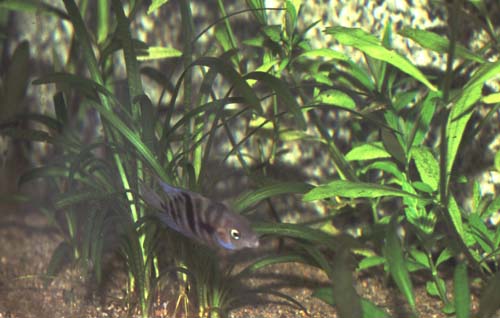

Name
T-Bar Cichlid
Archocentrus sajica
Also Known As
Cichlasoma sajica
Source
Pacific slope of Costa Rica
Water Requirements
Not sensitive. I have bred these fish in soft, slightly
alkaline tap water with no problems.
Temperature
Flexible in temperature, but breeds in the upper 70s. May not
breed at all below around 78 degrees. Will inhabit a room temperature
tank with no problems.
Life Span
Don't know, but probably same as similar Cichlids which is 10
years or more.
Size
Up to 5 inches.
Sex
Males are usually quite a bit larger than females, with slightly longer
fins. Mature females that are ready to spawn have a beautiful golden
yellow color on their dorsal and anal fins. This is the easiest method
for sexing in the fish I have have. The fish in the above picture
is a male. I find it easier to sex fish by behavior, shape, size and
color than by shape, size and color, alone.
Feeding
Not picky, my fish ate primarily a variety of dry processed foods.
For some reason, they would not eat Hikara brand foods, though.
I have spiced up the diet with earthworms and the occasional ant
or other insect, in the summer months.
Color:
My fish would develop a rich dark color with vertical stripes
and blue eyes when guarding a spawn. This color would gradually change
at spawning time reaching maximum effect once the fry become free swimming.
The females golden yellow color becomes very muted during these periods.
It appears that only the dominate female ready to breed displays the
golden yellow color on here fins. Submissive females look very similar
to males. The T-bar for which the fish is named, is not always obvious
in my fish, though it can be seen in the photo at the top of this page.
It is made up of the combination of two lines. One from behind
the head going back to mid body. The other is vertical near the end
of the first bar.
Behavior (not breeding)
Sajica's are fairly peaceful for Cichlids, at least until breeding time.
Males will nip and harass smaller males and females they are not interested
in, but if there is a small school in the tank, this aggression will be
spread out enough that no fish's life is threatened. I have never
seen them lock jaws at any time. They do dig quite a bit. I
found that my fish were not timid at all and swam freely throughout an aquarium,
even when only two were housed alone in a 55 gallon aquarium that was located
in a busy room in the house. They would swim to the top waiting to
be fed any time someone moved around in this room.
Breeding Behavior
These fish exhibits a version of Cichlid cave spawning behavior. I
recommend a temperature of around 78 degrees for spawning. They may
not spawn at lower temperatures. The males can be really tough on
a female that is not ready to spawn, to the point where he may kill her.
Once a pair reaches spawning readiness, all other fish in the tank
will be extensively harassed, probably resulting in death at some point.
It is probably best to remove other fish from the tank when spawning
behavior becomes evident. The females ovipositor becomes visible
a day or two before the actual spawning occurs. My Sajica's have spawned
in two locations. One was inside a cave they dug under a large rock.
The other was on the underside of a medium sized live plant leaf. This
leaf was right outside of a cave that was later used to house the hatched
fry. Spawn size in my fish seemed to be a couple of hundred eggs and
hatch in 3 to 4 days at 78 degrees. They become free swimming in another
7 days or so. Once the spawn hatch, the parents keep the fry in a cave
dug under rock until they are free swimming. This cave has a very
narrow clearance so that the female has to swim on her side to reach the
fry inside. Even after they are free swimming the female will move
the fry back to the cave if she feels that they are threatened.
The male is not very active in the care of the young, primarily patrolling
the general area. I have left the fry with a single male parent (the
female was killed by him) well past maturity, though they do become nippy
toward each other. Note, that in my experience, the male will be ready
to breed within about 2 weeks after the fry become free swimming. At
that point one of two things will happen. The female is ready to spawn
and that is what they will do. The existing fry will be driven away
or killed. The female is not ready to spawn and the the male will most
likely kill her, if they are not immediately separated.
Overall Recommendation
I am very pleased with these fish, as they are not as aggressive as
some other Cichlids, but still show interesting spawning behavior. I
think they make a far better selections that Jack Dempseys and Convicts for
beginning Cichlid breeders. Their color is very pleasing, if not brilliant
and they rarely hide from view.
References
1: Aquarium Atlas, Volume 2, H. A. Baensch, Dr Rudiger Riehl
Photo Gallery





